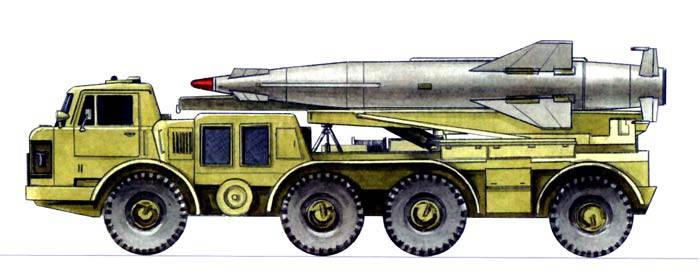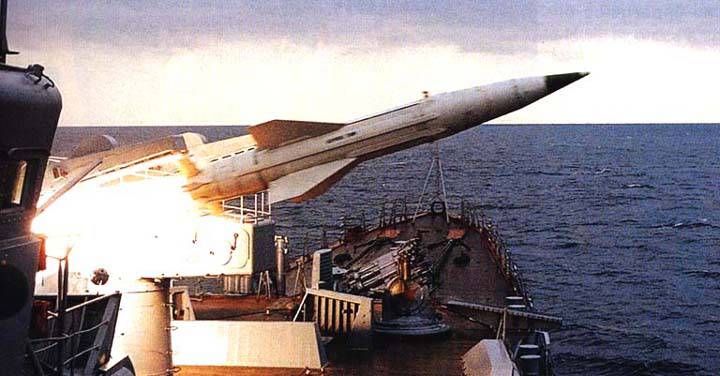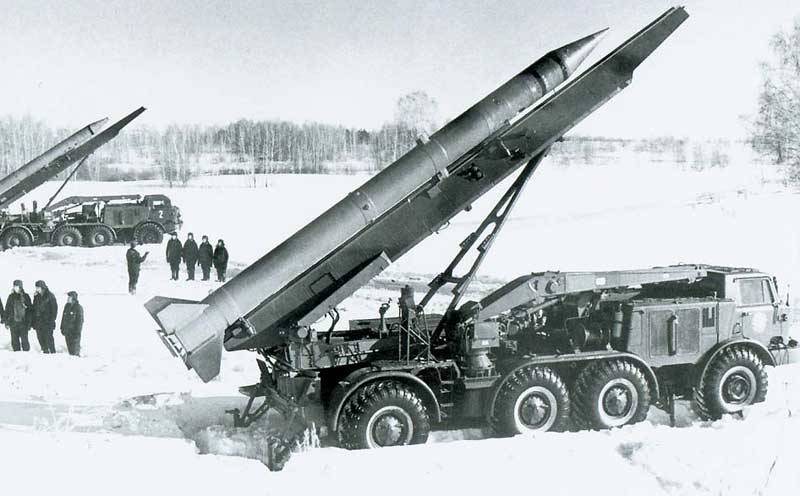Draft tactical missile complex "Tochka"
According to the available data, the research work “Kholm” showed that the greatest prospects are for missile systems with missiles using autonomous inertial guidance or radio-guided control. At the same time, experts preferred arms with its own guidance systems that do not require additional control from the side. Check out the new ideas proposed in two projects. The radio command control of the rocket should have been implemented within the framework of the project with the code “Yastreb”, and the inertial guidance system was to be used by the rocket of the “Tochka” complex.
It should be noted that the project "Point", the development of which began in the first half of the sixties, has a indirect relationship to the eponymous rocket complex, created by the early seventies. The older project influenced the development of a newer one, but there is no reason to consider the 9K79 “Point” system as a direct development of the previously created complex.

Estimated appearance of self-propelled launcher complex "Point". Figure Militaryrussia.ru
The development of the Tochka and Yastreb projects was entrusted to OKB-2 (now the Fakel ICD), headed by P.D. Pear. Also several other research and design organizations were involved in the work. Their task was to develop those or other radio-electronic systems, start-up units, etc. In particular, the OKB-221 plant "Barricades" (Volgograd) and the Bryansk Automobile Plant were responsible for creating a self-propelled launcher, and KB-11 had to submit a draft of a special warhead with the required parameters.
Preliminary study of two missile systems began in accordance with the decision of the Commission of the Supreme Economic Council on Military-Industrial Issues of March 11 of 1963. In February 1965, the USSR Council of Ministers decided to begin draft design. The first projects should be completed by the third quarter of the same year. In the future, it was supposed to prepare full-fledged projects and bring new complexes to the stage of field tests.
In the “Point” project it was proposed to use a fairly economical approach to the creation of individual elements of the missile complex. All its components were to be based on existing products. So, it was proposed to build a self-propelled launcher on the basis of one of the new chassis, and a rocket with the designation B-614 was to be the development of anti-aircraft B-611 from the M-11 Storm complex. At the same time, for use in the “Tochka” complex, the existing products needed some kind of refinement.
As part of the “Point” project, it was decided to abandon the development of an entirely new rocket carrier vehicle. A self-propelled launcher for this system was planned to be built on the basis of the already developed chassis, and in the development of special equipment to use the existing units of other missile systems. Such an approach in the future made it possible to simplify the production of serial equipment, as well as to facilitate its operation in the army.
As a basis for the self-propelled launcher, a special chassis ZIL-135LM was chosen, the production of which was being prepared at that time at the Bryansk Automobile Plant. Unlike the base model of its family, this chassis did not have the ability to cross water obstacles by swimming, but could carry rocket and other special equipment. Characteristics of the machine ZIL-135LM fully comply with the requirements.
The chassis ZIL-135LM had an original design with a non-standard architecture of the power plant and chassis. On the frame of the car, the frameless structure was fastened with a front-facing crew cabin and a engine compartment placed behind it. In the engine compartment were placed two diesel engines ZIL-375Я power 180 hp each. Each of the engines mated with its own transmission system, transmitting torque to the wheels of its side. Due to this, increased the basic characteristics of mobility and carrying capacity.
The chassis of the special machine also differed unusual design and appearance. Four bridges were used, the distance between which was different: the two central bridges were located as close as possible to each other, while the front and rear bridges were removed from them. The central axles did not have an elastic suspension, and the steering wheels of the front and rear axle received a torsion suspension with independent hydraulic shock absorbers.
With its own weight of 10,5, the ZIL-135LM could transport up to 9 and various cargoes. There was also the possibility of towing trailers of greater weight. Maximum speed on the highway reached 65 km / h, power reserve - 520 km.
The project of the self-propelled launcher provided for equipping the existing chassis with a number of special equipment. So, for leveling while firing, the chassis should have been completed with jack-supports. In addition, the launcher should have equipment for topographic targeting and preparing the rocket for firing. Finally, in the stern of the chassis should have been placed swinging guide for the rocket.

The launch of the B-611 rocket complex "Storm". Photos Flot.sevastopol.info
For the new rocket, a beam guideline of a fairly simple design was developed. It was a beam of sufficient length with mounts for installing the rocket. Due to the grooves and other equipment of the upper surface, the guide had to hold the rocket in the required position, as well as ensure its correct movement during initial acceleration. For raising to the required angle of elevation, the guide has received hydraulic drives.
A transport-loading vehicle could be included in the Tochka missile system. Information about the existence of such a project has not been preserved. As a result, the proposed features of such a machine are unknown. Probably, it could be built on the same chassis as the self-propelled launcher, and receive the appropriate set of equipment in the form of mounts for transporting missiles and a crane to overload them on the launcher.
Development of a ballistic missile under the designation B-614 was proposed on the basis of anti-aircraft B-611, created at that time. The B-611 or 4K60 was originally designed for use as part of the M-11 “Storm” anti-aircraft missile system. A characteristic feature of this product was a relatively long range at 55 km and a relatively heavy 125-kg warhead. After analyzing the possibilities, it was found that a number of improvements will allow the anti-aircraft missile for ships to be converted into a ground-to-earth ballistic missile suitable for use in the land complex.
In the original version of the rocket B-611 had a body length of 6,1 m and a maximum diameter of 655 mm, consisting of several main sections. The head fairing had a conical shape and mated with a cylindrical central compartment. In the tail part of the body there was a conical narrowing. Anti-aircraft missile had a set of X-shaped wings in the rear of the cylindrical section of the hull. In the tail was a set of steering wheels. In the B-614 project, the body design had to be slightly modified. Due to the different parameters of the warhead, which was distinguished by its great weight, the head fairing of the rocket had to be equipped with additional aerodynamic destabilizers of small size.
The ballistic missile could save the solid engine of the base product. In the project B-611, a dual-mode engine was used, which provided the initial acceleration of the missile with a derailment from the guide, and then supported the required flight speed. The anti-aircraft missile could accelerate to 1200 m / s and fly at a cruising speed of 800 m / s. The range of the B-611 product was 55 km. Interestingly, the existing supply of fuel provided a long active site, equal to the maximum firing range. Such engine parameters were of great interest from the point of view of the development of a ballistic missile.
The B-611 missiles of the Storm anti-aircraft complex and the B-612 tactical system Yastreb were proposed to be equipped with a radio command system. The product B-614, in turn, was to receive autonomous control devices based on an inertial system. With their help, the rocket was able to independently monitor flight parameters and maintain the desired trajectory throughout the active leg of the flight. Next was to be uncontrolled flight to the point of incidence.
The armament of promising missile systems was planned to be equipped with special combat units. These products were noticeably heavier than the standard high-explosive warhead of the B-611 rocket, which led to improvements in the hull structure. The power of the special warhead developed for the B-614 product is unknown.
According to the customer’s requirements, the Tochka missile system was to ensure the destruction of targets at ranges from 8 to 70 km. Due to the control systems, it was planned to bring the accuracy of hitting targets to the required level. A special warhead of sufficient power could compensate for the deviation from the aiming point.
Due to the presence of its own missile control systems, the Tochka complex should not differ from other systems of its class. Arriving at the position, the crew had to perform topoprivity, and then count the flight program of the rocket and enter it into the control system. At the same time, the combat vehicle was hung on supports with the subsequent raising of the launch guide to the required angle of elevation. After completion of all necessary procedures, the calculation could launch the rocket. Then, immediately after the launch, it was possible to transfer the complex to the marching position and leave the firing position.

The rocket complex 9K52 "Luna-M" on the position: in a similar way the system "Point" should have looked. Photo Rbase.new-factoria.ru
Approximately in 1965, a draft version of the “Point” project was developed, after which the work was stopped. The exact reasons for this are unknown. Probably, the same factors that led to the creation of the “Hawk” complex affected the fate of the development. The chosen method of creating a promising ballistic missile with the maximum possible use of B-611 product units did not justify itself. Despite all the improvements, the anti-aircraft missile could not become a suitable basis for an air-to-air system. For this reason, further work on the “Point” project in its current form was canceled.
As far as we know, the project OKB-2 / ICD "Torch" with the cipher "Point" was closed in the mid-sixties. The development was in the early stages, because of which the assembly and testing of individual elements of the missile complex was not carried out. Thus, all conclusions about the prospects of the project were made only from the results of the theoretical assessment of the project, without experience and testing in practice.
Interestingly, the project "Point" was not forgotten and yet led to the emergence of certain positive results. Soon after the completion of the work, OKB-2 transferred all the available documentation on this project to the Kolomna Engineering Design Bureau. The specialists of this organization, headed by S.P. Invincible, after analyzing the documents, studied the experience of others and developments. Soon, KBM began developing a new project for a promising tactical missile system. It was planned to use certain ideas of the old project “Tochka”, which were revised and refined to meet the requirements of the customer and the own experience of Kolomna designers.
By 1970, the project of the complex from KBM was brought to the test of experimental equipment. Earlier this development received the designation "Point" and the index GRAU 9K79. A few years later the complex 9K79 "Tochka" was adopted and entered into mass production. The operation of such complexes of several modifications that use guided ballistic missiles of the 9М79 family continues to this day. Even now they remain the main systems of their class in the Russian missile forces and artillery.
The project of the tactical missile system "Tochka" was created with the aim of implementing new original ideas concerning the approach to the development of missiles and their control systems. In its original form, the project had a lot of flaws that did not allow it to go out of the early stages. However, just a few years after the cessation of work, this development contributed to the emergence of a new missile system, which was successfully brought to mass production and operation in the army.
On the materials of the sites:
http://rbase.new-factoria.ru/
http://pvo.guns.ru/
http://flot.sevastopol.info/
http://militaryrussia.ru/blog/topic-260.html
Information